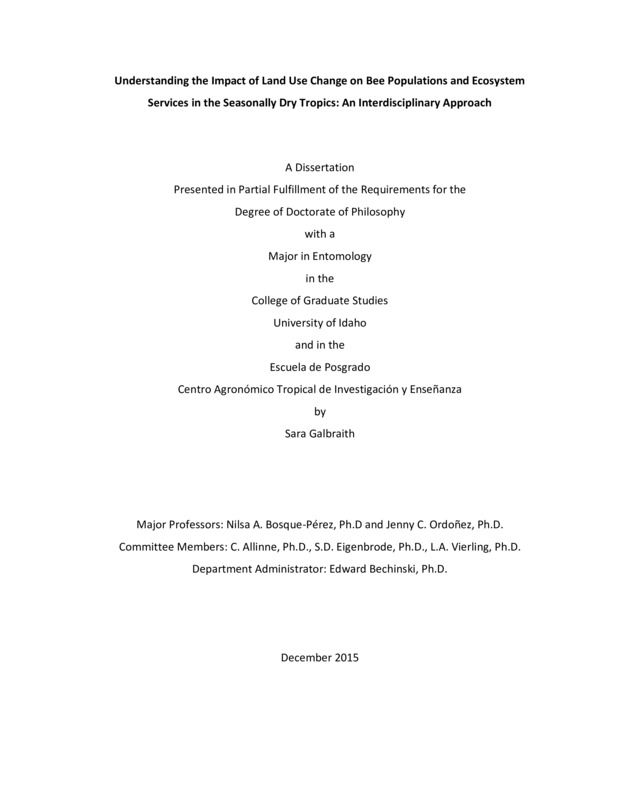Understanding the Impact of Land Use Change on Bee Populations and Ecosystem Services in the Seasonally Dry Tropics: An Interdisciplinary Approach
Galbraith, Sara Marie. (2015). Understanding the Impact of Land Use Change on Bee Populations and Ecosystem Services in the Seasonally Dry Tropics: An Interdisciplinary Approach. Theses and Dissertations Collection, University of Idaho Library Digital Collections. https://www.lib.uidaho.edu/digital/etd/items/galbraith_idaho_0089e_10763.html
- Title:
- Understanding the Impact of Land Use Change on Bee Populations and Ecosystem Services in the Seasonally Dry Tropics: An Interdisciplinary Approach
- Author:
- Galbraith, Sara Marie
- Date:
- 2015
- Embargo Remove Date:
- 2017-12-15
- Keywords:
- bees biodiversity Costa Rica ecosystem services interdisciplinary payments for ecosystem services
- Program:
- Plant, Soil and Entomological Sciences
- Subject Category:
- Ecology; Entomology; Environmental studies
- Abstract:
-
Abstract
Over the past century, humans have made unprecedented changes to the world's ecosystems, causing global ecosystem service (ES) loss. More information on the relationship between land use and ES provision is needed to improve policy design and resource allocation in heterogeneous agroecosystems. In this study, we used a team-based interdisciplinary approach to understand the impact of land use change on ES in the Nicoya Peninsula of Costa Rica. This region has undergone dramatic land use changes in the past century, and recent reforestation has been attributed to socio-economic drivers as well as a combination of multi-scalar conservation policies, including Payments for Ecosystem Services (PES). We investigated the relative impact of human-dominated land uses on bee populations, which are a proxy for pollination services. We found that bee populations vary with altitudinal and seasonal changes, and that among low altitude land uses, teak plantations have significantly lower bee abundance, richness, diversity, and evenness than pastures. In addition, we observed changes in the relative abundance of functional groups, with large sized cavity-nesting bees, buzz pollinating bees, and moderate to small sized bee specialists being less represented in teak plantations compared to coffee agroforestry and pastures. To determine the value of these land uses to a group of non-landowners, we then explored a mixed-methods approach for the valuation of ES based on local ecological knowledge. We found that beekeepers perceive a loss of provisioning services (i.e., honey production) due to recent land use changes, and that they prefer native forests for beekeeping. We also found that they are most limited by access, rather than existing land cover in the region. To address the large scale of ES management, we reviewed current methods and future opportunities for applying remote sensing tools to the study of bees and other ES-providing insects. Finally, we explored the potential for using functional trait measurements, which are most often measured at the plot scale, for landscape-scale ES management. We discuss the proxies and metrics used to determine different types of ES based on functional trait measurements, and outline a framework for upscaling multiple ES to assess conservation policy.
- Description:
- doctoral, Ph.D., Plant, Soil and Entomological Sciences -- University of Idaho - College of Graduate Studies, 2015
- Major Professor:
- Bosque-Pérez, Nilsa A; Ordoñez, Jenny C
- Committee:
- Allinne, Clementine; Eigenbrode, Sanford D; Vierling, Lee A
- Defense Date:
- 2015
- Identifier:
- Galbraith_idaho_0089E_10763
- Type:
- Text
- Format Original:
- Format:
- application/pdf
- Rights:
- In Copyright - Educational Use Permitted. For more information, please contact University of Idaho Library Special Collections and Archives Department at libspec@uidaho.edu.
- Standardized Rights:
- http://rightsstatements.org/vocab/InC-EDU/1.0/

